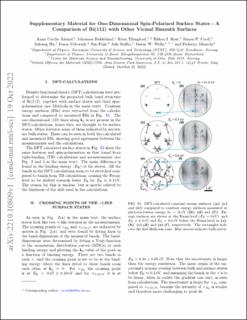| dc.contributor.author | Åsland, Anna Cecilie | |
| dc.contributor.author | Bakkelund, Johannes | |
| dc.contributor.author | Thingstad, Even | |
| dc.contributor.author | Røst, Håkon | |
| dc.contributor.author | Cooil, Simon Phillip | |
| dc.contributor.author | Hu, Jinbang | |
| dc.contributor.author | Vobornik, Ivana | |
| dc.contributor.author | Fujii, Jun | |
| dc.contributor.author | Sudbø, Asle | |
| dc.contributor.author | Wells, Justin William | |
| dc.contributor.author | Mazzola, Federico | |
| dc.date.accessioned | 2023-12-04T13:44:03Z | |
| dc.date.available | 2023-12-04T13:44:03Z | |
| dc.date.created | 2023-11-03T12:10:16Z | |
| dc.date.issued | 2023 | |
| dc.identifier.issn | 2469-9950 | |
| dc.identifier.uri | https://hdl.handle.net/11250/3105847 | |
| dc.description.abstract | Vicinal surfaces of bismuth are unique test beds for investigating one-dimensional (1D) spin-polarized surface states that may one day be used in spintronic devices. In this paper, such states have been observed for the (112) surface when measured using angle- and spin-resolved photoemission spectroscopy, and also when calculated using a tight-binding model and with density functional theory. The surface states appear as elongated Dirac-cones which are 1D and almost dispersionless in the k y direction, but disperse with energy in the orthogonal k x direction to form two × -like features centered at the k y line through ¯¯¯ Γ . Unlike many materials considered for spintronic applications, their 1D nature suggests that conductivity and spin-transport properties are highly dependent on direction. The spin polarization of the surface states is mainly in plane and parallel to the 1D states, but there are signs of a tilted out-of-plane spin-vector component for one of the features. The Bi(112) surface states resemble those found for other vicinal surfaces of bismuth, strongly indicating that their existence and general properties are robust properties of vicinal bismuth surfaces. Furthermore, differences in the details of the states, particularly related to their spin polarization, suggest that the electronic band structure may be engineered simply by precise cutting and polishing of the crystal. | en_US |
| dc.description.abstract | One-dimensional spin-polarized surface states: A comparison of Bi(112) with other vicinal bismuth surfaces | en_US |
| dc.language.iso | eng | en_US |
| dc.publisher | American Physical Society | en_US |
| dc.relation.uri | https://journals.aps.org/prb/pdf/10.1103/PhysRevB.108.205403 | |
| dc.rights | Navngivelse 4.0 Internasjonal | * |
| dc.rights.uri | http://creativecommons.org/licenses/by/4.0/deed.no | * |
| dc.title | One-dimensional spin-polarized surface states: A comparison of Bi(112) with other vicinal bismuth surfaces | en_US |
| dc.title.alternative | One-dimensional spin-polarized surface states: A comparison of Bi(112) with other vicinal bismuth surfaces | en_US |
| dc.type | Peer reviewed | en_US |
| dc.type | Journal article | en_US |
| dc.description.version | acceptedVersion | en_US |
| dc.source.volume | 108 | en_US |
| dc.source.journal | Physical review B (PRB) | en_US |
| dc.identifier.doi | 10.1103/PhysRevB.108.205403 | |
| dc.identifier.cristin | 2191871 | |
| dc.relation.project | Norges forskningsråd: 323766 | en_US |
| dc.relation.project | Norges forskningsråd: 262633 | en_US |
| cristin.ispublished | true | |
| cristin.fulltext | postprint | |
| cristin.fulltext | original | |
| cristin.qualitycode | 2 | |

